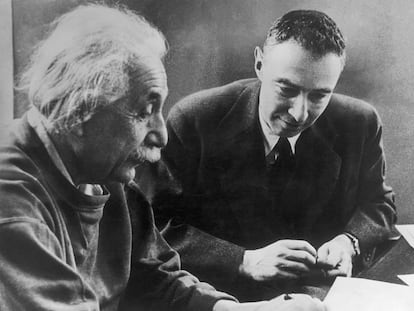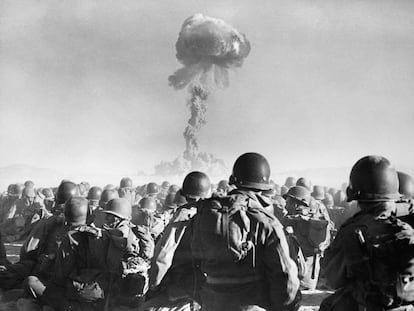From the Spanish Civil War to Gaza and Ukraine: A history of bombings targeting civilians
Researcher Sheldon Garon highlights the precedent that the Spanish conflict represented in the generalization of a tactic aimed at breaking the morale of the population
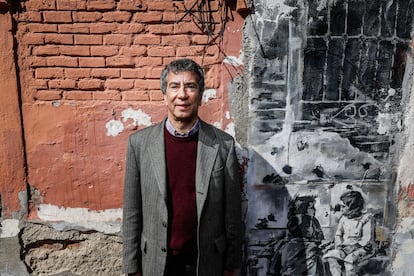
The house at number 10 Peironcely Street in Madrid seems to be frozen in time. Uninhabited, with exposed brick and sealed off to deter squatters, it is the only one-story house among the surrounding multi-story buildings in the Entrevías neighborhood of the Spanish capital. This property became one of the most famous monuments to the bombing of Madrid by Francisco Franco’s Nationalist forces during the Spanish Civil War (1936-1939) and was immortalized by photographer Robert Capa at the beginning of the conflict. It was also the first place in Spain that Princeton University historian Sheldon Garon visited to research his book The Global War on Civilians, 1905-1945. It is a symbol of what he describes as an “important turning point” in the history of the aerial bombardment of civilians, a strategy that dates back to the beginning of the 20th century and is being carried out today on populations in Gaza and Ukraine. Madrid was the first capital city to be continuously bombed, causing an alarming number of victims. His next destination was Barcelona, a city to which he attributes the genesis of air-raid shelters built by civilians. Those in Barcelona were highly organized and served as a reference point for the United Kingdom and France in World War II (1939-1945).
“Aerial bombing started in World War I (1914-1918). The Germans bombed London and Paris particularly, but on a small scale, leaving just under 1,000 dead in the former and about 250 in the latter,” explains Garon, who quotes Hispanist historian Hugh Thomas to recall that around 2,000 people died in Madrid. The strategy of targeting civilians used by the Nationalist forces, using the German pilots and aircraft of the Condor Legion, was greatly intensified in later conflicts: World War II, the Second Sino-Japanese War (1937-1945), the Vietnam War (1955-1975), up to the present day in Ukraine and Gaza.
“Instead of simply targeting armies and navies of the enemy, you target their cities and their civilians,” the American details. “You bomb densely populated areas, usually working class areas, with the objective of trying to win the war by breaking the morale of the civilians so they will pressure their government to surrender. That was the rationale in the Spanish Civil War.” That several countries resorted to the same tactic in the same time-period was not coincidental. In his book, Garon connects the different cases to provide a complete picture using a methodology known as transnational history.

At the same time that Franco was bombing Madrid in an attempt to break Republican resistance, Japan was attempting to cow China by targeting the cities of Shanghai, Nanjing, and particularly Chongqing, the capital during the Second Sino-Japanese War, which suffered four years of aerial bombardment with an approximate death toll of 9,000. “Nobody is safe, nobody is protected, there’s no difference between civilians and soldiers. Civilians are simply considered soldiers at home,” Garon says to explain “the concept of total war.”
If Madrid was important in understanding the offensive aspect of aerial bombardments, Barcelona had the same importance in understanding the rearguard, what Garon refers to as the home fronts. “In Barcelona in 1937 they had a lot of time to prepare and they built many shelters. It was far from the front. So Barcelona had a lot of time to prepare, unlike Madrid.” The population of the Catalan capital, the last bastion of the Republican government, formed neighborhood organizations that provided first aid, distributed food rations, set up guards on the tops of buildings to warn of approaching planes, dug trenches, and sheltered children.
“Barcelona became a model to other Europeans at the time, because in the First World War there weren’t many shelters in London and Paris. The British and the French had observers in Barcelona and they studied the shelters. It was almost a laboratory for them. By the time World War II started they had all organized home fronts,” he points out. “So, again, it’s a transnational history.”
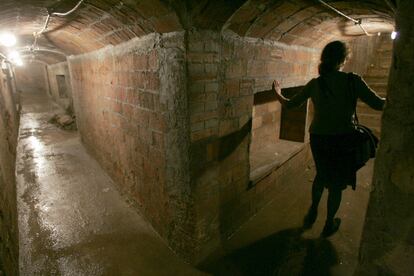
It is impossible to talk of aerial attacks on cities without mentioning Germany. The United States and the United Kingdom had destroyed 200 by 1944, mainly industrial areas such as Hamburg, Dresden, and the Rhine Valley. In France, 70% of Cannes was destroyed, Garon estimates. In Japan, 66 cities were devastated, two by atomic bombs and the rest by incendiary devices. This intimidating strategy had already been used in the 1920s and 1930s against insurgencies in the colonies. In 1926, Spain and France bombed the rebels in Morocco in the Rift Valley, and the United Kingdom did the same shortly afterwards against those seeking independence in Somaliland and Iraq.
Garon’s research ends with the conclusion of World War II, but the dropping of bombs targeting the civilian population “continues to the present day, unfortunately.” The U.S. became the biggest exponent of bombing campaigns in the second half of the 20th century, in Vietnam (where deadly napalm fuel was dropped), North Korea (as part of the Korean War of 1950-1953) and in Iraq in the 1991 Gulf War.
All the cases detailed by Garon reverberate today with Ukraine and Gaza, although incendiary and heavy bombs have been exchanged for ballistic missiles and drones. “The scale and the technologies become much more sophisticated, but the strategies don’t change much: the demoralization of the population.” The United Nations has condemned reports of Israeli attacks in the Strip against hospitals and refugee camps and some 70% of the more than 30,000 Palestinians killed during the war are women and children. On the other hand, the Kremlin has consistently targeted the Ukrainian power grid but has also attacked Kyiv and other cities with aerial strikes.
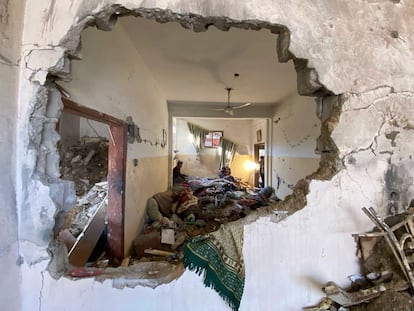
International rules of engagement have not been able to deter warring nations from using weapons against civilians. There are laws such as the 1923 Hague Regulations on aerial warfare, which prohibited the bombing of cities that were not being attacked from the ground, or the Fourth Geneva Convention in 1949, which was created precisely to protect the population in times of war. However, they have been regularly violated under the claim that military targets are mixed among civilians.
This willingness to use the citizenry as a means of warfare was verified by Garon when he gained access to official documents. The 1941 British Air Force files noted that the new targets were not industrial factories or port cities, but “the morale of the German people.” Other records detailed the types of poison effective against rebels in British colonies. Garon highlights the one that shocked him most: “When the U.S. was fighting the Japanese in 1945, they blockaded food supplies to Japan. They called it Operation Starvation and the goal was to cut 20% to 30% of the calories that the Japanese people consumed.”
Sign up for our weekly newsletter to get more English-language news coverage from EL PAÍS USA Edition
Tu suscripción se está usando en otro dispositivo
¿Quieres añadir otro usuario a tu suscripción?
Si continúas leyendo en este dispositivo, no se podrá leer en el otro.
FlechaTu suscripción se está usando en otro dispositivo y solo puedes acceder a EL PAÍS desde un dispositivo a la vez.
Si quieres compartir tu cuenta, cambia tu suscripción a la modalidad Premium, así podrás añadir otro usuario. Cada uno accederá con su propia cuenta de email, lo que os permitirá personalizar vuestra experiencia en EL PAÍS.
¿Tienes una suscripción de empresa? Accede aquí para contratar más cuentas.
En el caso de no saber quién está usando tu cuenta, te recomendamos cambiar tu contraseña aquí.
Si decides continuar compartiendo tu cuenta, este mensaje se mostrará en tu dispositivo y en el de la otra persona que está usando tu cuenta de forma indefinida, afectando a tu experiencia de lectura. Puedes consultar aquí los términos y condiciones de la suscripción digital.
More information
Archived In
Últimas noticias
Welcome to the post-religion era: The idea of Christianity as the absolute truth has become obsolete
‘I thought you would like it’: The risky sexual practice popularized by TV shows and TikTok
The digitalization of tourism: ‘They promise experiences and gave us the worst possible one’
Mexican peso defies uncertainty with forecasts of a new period of stability in 2026
Most viewed
- Sinaloa Cartel war is taking its toll on Los Chapitos
- Reinhard Genzel, Nobel laureate in physics: ‘One-minute videos will never give you the truth’
- Oona Chaplin: ‘I told James Cameron that I was living in a treehouse and starting a permaculture project with a friend’
- Why the price of coffee has skyrocketed: from Brazilian plantations to specialty coffee houses
- Silver prices are going crazy: This is what’s fueling the rally

